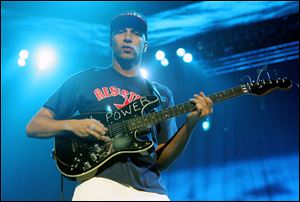
Morello channels rage into the world of comics
8/29/2011
Guitarist Tom Morello is moving into a new career as a storyteller.
LOS ANGELES — Tom Morello, a man with searing musical ability and scorching political passions, is famous as the guitarist in Rage Against the Machine and Audioslave and, increasingly, for his solo folk project The Nightwatchman. Now, like his friend Gerard Way of My Chemical Romance, the amplifier auteur is moving into a new career as a storyteller in the comics world. Orchid arrives in October from Dark Horse Comics, with art by Scott Hepburn.
Q. Are comics a new passion for you?
A. I was an avid comic book collector as a kid. At the time my comic book tastes and my music tastes coincided, they were escapist in nature. It was kind of heavy metal, Zeppelin, KISS, Alice Cooper, Iron Man, Avengers, and Weird War Tales. I had about 6,500 comics that were in my mom’s basement until I recently brought them out here, and now I’ve been going through them. But anyway, back when I picked up a guitar and discovered the Clash and the Sex Pistols, comic books just went away. It just didn’t feel like it spoke to me in the same way. I went on with my rock career and comics were just part of my background.
Q. When did that change? When did you also start seeing comics or graphic novels as part of your present and future?
A. It was a few years ago that I decided I had a story to tell. I was searching for a medium to tell it effectively. I wanted to tell an epic fantasy tale like Lord of the Rings, like a Star Wars but with a class consciousness. The template was Star Wars meets the Battle of Algiers, something that had the street politics of terror mixed with an exciting, huge, over-arching story with monsters and escapes and amazing settings. But I did not want to be another jackass with a screenplay and I did not have time to write a 600-page book. So I started researching graphic novels and I found that, as I suspected, they had come a long way since I put them down as a 17-year-old.
Q. That must have been a pretty exciting time of discovery for you.
A. It was incredible. It’s a great artistic medium. So then I flushed out a 30-page script of the story from beginning to end. Then I spoke to Gerard Way from My Chemical Romance, who introduced me to my Dark Horse family. They seemed very excited and it’s been quite a ride since. One important component in addition to all of that is that I’m scoring each comic book issue. So when you buy the comic book you will get a free (digital track); it will be a 12-issue arc and there will be a 12-track CD at the end of it.
Q. Did your experience making music for Iron Man 2 inform that process?
A. Absolutely. It was inspired by that experience and I’ve scored a few other films as well. I also saw the Ashes and Snow art exhibit in L.A. a few years ago and it was an art show with a soundtrack and I thought, “How interesting is that?” That was on my mind too.
Q. With Rage and with Audioslave you know all the benefits and challenges of being in a world-class band. Collaboration isn’t always easy, either, which you know as well as anyone. This is a new medium for you that is also defined by collaboration. Did your band experience give you insights in this new field?
A. Very much, and it also threw up some warning signs. Scott Hepburn is the illustrator and he’s really great but it took a year to find the right illustrator. Some very big names in the comics world threw their hats in the ring and after speaking with them I decided I needed to find someone that I had a great chemistry with. It’s just like in a band: You need that chemistry to effectively convey an artistic vision and have a great experience doing it. When Scott and I began working together, it was crystal clear he was the right guy to do it.
Q. What can you say about the setting, the tone, or the characters?
A. There’s touchstones I told you about and then the main character, Orchid, she’s part Suicide Girl and part Joan of Arc. It’s a dystopian future. It’s no longer the haves and the have-nots, it’s the haves and the have-nothings. I wanted the main character to come from the lowest rung of the ladder. She’s a teenager. She’s a woman. She’s destitute. She’s a sex-trade worker. That’s your hero.
I loved Star Wars and Lord of the Rings but the class angle of those stories always irked me. I remember reading Lord of the Rings and thinking, “You know those Orcs and the vassals of Minas Tirith have more in common with one another than they do with the king and the dark lord.” So that’s one element I felt is missing from things like Star Wars and Dune and my other favorites. I wanted to keep the exciting elements from those stories — the big mythology and the battle tableaux and the quests — but it’s also infused with my world views.